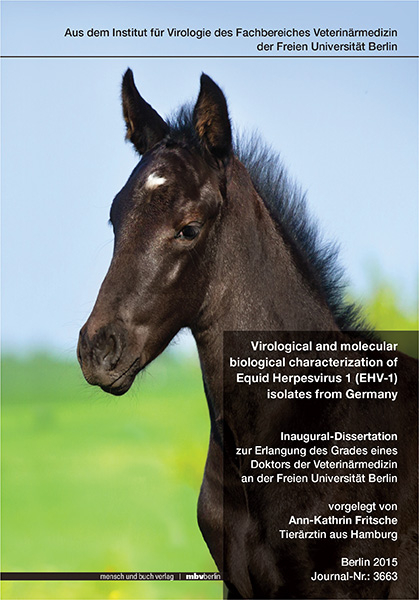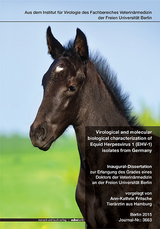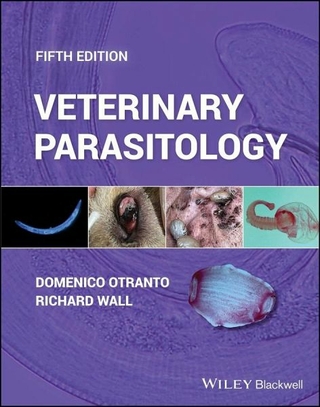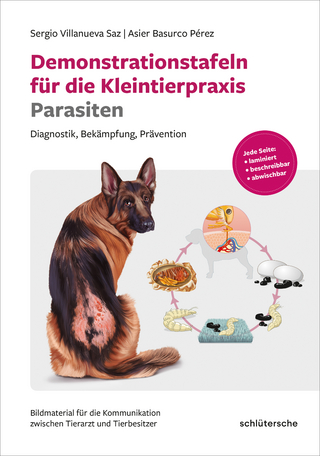Virological and molecular biological characterization of Equid Herpesvirus 1 (EHV-1) isolates from Germany
Seiten
2015
|
1. Aufl.
Mensch & Buch (Verlag)
978-3-86387-648-7 (ISBN)
Mensch & Buch (Verlag)
978-3-86387-648-7 (ISBN)
- Keine Verlagsinformationen verfügbar
- Artikel merken
In this study, the non-neuropathogenic genotype (N752/A2254) was detected in 88.1% (59/67) of the EHV-1 abortion isolates. The neuropathogenic genotype (D752/G2254) was detected in 11.9% (8/67).
The infection with the neuropathogenic EHV-1 strain did not necessarily result in neurological signs. Only two of the mares (2/8) with the neuropathogenic genotype showed neurological signs prior to abortion.
Another mutation at nt position 2258 was found, an amino acid change from Y to S753 was recognized in EHV-1 reference strain Ab4, RacH and abortion T952 (single abortion case). The amino acid changes at position 752 and 753 possibly correspond with the outcome of the neuropathogenic potential. Further investigations are needed to clarify if there is a correlation. In two abortion isolates (A(E) 271-3, A 258) from single abortion cases from the year 2004 the nucleotide guanine (G2269) was exchanged to adenine (A2269), an amino acid change from glutamic acid to lysine resulted (E 757 to K 757).
In six archived wild equid isolates and in two cattle isolates the neuropathogenic genotype G2254 was found. In three wild equid ORF 30 amplicons the sequencing revealed an additional nucleotide change from G to A at position 2262, no amino acid exchange resulted. In this study, a clinical healthy stallion was found to have the neuropathogenic genotype in semen. Further studies should be performed to examine if EHV-1 was excreted via semen and if the infectivity remained.
The detection of virus in PBMC via ORF 30 nested PCR succeeded in this study only twice and it is questionable whether this low detection rate depends on the stage of infection (active or latent) or the detection method.
The ORF 30 nested PCR was found to be a fast and safe method to differentiate neuropathogenic from non-neuropathogenic EHV-1 strains. However, the typing of the strains should not influence the stud farm management in the case of outbreak, as both strains - neuropathogenic and non-neuropathogenic - have the potential to cause disease. - Virologische und molekularbiologische Charakterisierung von equinen Herpesvirus 1 (EHV-1) Isolaten in Deutschland -
In dieser Studie wurde der nicht-neuropathogene Genotyp (N752/A2254) in 88.1% (59/67) der EHV-1 Abortisolate gefunden. Der neuropathogene Genotyp (D752/G2254) wurde in 11.9% (8/67) gefunden.
Nur zwei der acht Stuten mit dem Nachweis des neuropathogenen Genotyps zeigten zusätzlich zum Abort auch neurologische Symptome. Eine Infektion mit dem neuropathogenen EHV-1 mündet also nicht zwangsläufig in einer neurologischen Verlaufsform.
An der Nukleotidposition 2258 wurde eine weitere Mutation im ORF 30 des EHV-1 Referenzstammes Ab4, RacH und Abortprobe T952 (Einzelabort) gefunden. Ein Aminosäurewechsel von Y zu S 753 ist die Folge. Ein Zusammenhang des Aminosäureaustausches der Positionen 752 und 753 und damit eine Beeinflussung des neuropathogenen Potentials ist in Diskussion. Es sollten sich weitere Untersuchungen anschliessen.
Bei zwei Abortisolaten (A(E) 271-3, A 258) von Einzelaborten aus dem Jahr 2004 wurde anstatt Gunanin (G2269) Adenin (A2269) gefunden. Dies resultierte im Aminosäurewechsel von Glutamins äure zu Lysin (E 757 zu K 757).
In sechs archivierten Wildequidenisolaten und 2 Isolaten von Rindern wurde der neuropathogene Genotyp (G2254) gefunden. In den ORF 30 Amplikons von 3 Wildequiden wurde durch die Sequenzierung an der Nukleotidposition 2262 ein Wechsel von G auf A festgestellt, daraus resultierte kein Aminosäurewechsel.
Bei einem klinisch unauffälligen Hengst von Gestüt 3 wurde im Sperma der neuropathogene EHV-1 Stamm nachgewiesen. Auf demselben Gestüt wurde bei zwei Stuten mit Aborten und neurologischen Symptomen ebenfalls der neuropathogene Genotyp festgestellt. Es wäre anzuraten weitere Spermaproben zu untersuchen, um festzustellen ob EHV-1 über Sperma ausgeschieden wird und ob EHV-1 infektiös bleibt.
Der Virusnachweis aus PBMCs per ORF 30 nested PCR gelang nur zweimal. Es ist die Frage ob diese niedrige Nachweisrate an dem Stadium der Infektion (aktiv oder latent) liegt oder der Untersuchungsmethode.
Die ORF 30 nested PCR stellt eine schnelle und sichere Methode dar um neuropathogene und nicht-neuropathogene EHV-1 Genotypen zu unterscheiden. Die Kategorisierung in neuropathogene und nicht-neuropathogene EHV-1 Stämme sollte jedoch das Management im EHV-1 Ausbruchsfall nicht beeinflussen. Beide Genotypen haben das Potential schwere Erkrankungen auszulösen und es sollten bei Verdacht strenge Hygiene- und Quarantänemassnahmen getroffen werden.
The infection with the neuropathogenic EHV-1 strain did not necessarily result in neurological signs. Only two of the mares (2/8) with the neuropathogenic genotype showed neurological signs prior to abortion.
Another mutation at nt position 2258 was found, an amino acid change from Y to S753 was recognized in EHV-1 reference strain Ab4, RacH and abortion T952 (single abortion case). The amino acid changes at position 752 and 753 possibly correspond with the outcome of the neuropathogenic potential. Further investigations are needed to clarify if there is a correlation. In two abortion isolates (A(E) 271-3, A 258) from single abortion cases from the year 2004 the nucleotide guanine (G2269) was exchanged to adenine (A2269), an amino acid change from glutamic acid to lysine resulted (E 757 to K 757).
In six archived wild equid isolates and in two cattle isolates the neuropathogenic genotype G2254 was found. In three wild equid ORF 30 amplicons the sequencing revealed an additional nucleotide change from G to A at position 2262, no amino acid exchange resulted. In this study, a clinical healthy stallion was found to have the neuropathogenic genotype in semen. Further studies should be performed to examine if EHV-1 was excreted via semen and if the infectivity remained.
The detection of virus in PBMC via ORF 30 nested PCR succeeded in this study only twice and it is questionable whether this low detection rate depends on the stage of infection (active or latent) or the detection method.
The ORF 30 nested PCR was found to be a fast and safe method to differentiate neuropathogenic from non-neuropathogenic EHV-1 strains. However, the typing of the strains should not influence the stud farm management in the case of outbreak, as both strains - neuropathogenic and non-neuropathogenic - have the potential to cause disease. - Virologische und molekularbiologische Charakterisierung von equinen Herpesvirus 1 (EHV-1) Isolaten in Deutschland -
In dieser Studie wurde der nicht-neuropathogene Genotyp (N752/A2254) in 88.1% (59/67) der EHV-1 Abortisolate gefunden. Der neuropathogene Genotyp (D752/G2254) wurde in 11.9% (8/67) gefunden.
Nur zwei der acht Stuten mit dem Nachweis des neuropathogenen Genotyps zeigten zusätzlich zum Abort auch neurologische Symptome. Eine Infektion mit dem neuropathogenen EHV-1 mündet also nicht zwangsläufig in einer neurologischen Verlaufsform.
An der Nukleotidposition 2258 wurde eine weitere Mutation im ORF 30 des EHV-1 Referenzstammes Ab4, RacH und Abortprobe T952 (Einzelabort) gefunden. Ein Aminosäurewechsel von Y zu S 753 ist die Folge. Ein Zusammenhang des Aminosäureaustausches der Positionen 752 und 753 und damit eine Beeinflussung des neuropathogenen Potentials ist in Diskussion. Es sollten sich weitere Untersuchungen anschliessen.
Bei zwei Abortisolaten (A(E) 271-3, A 258) von Einzelaborten aus dem Jahr 2004 wurde anstatt Gunanin (G2269) Adenin (A2269) gefunden. Dies resultierte im Aminosäurewechsel von Glutamins äure zu Lysin (E 757 zu K 757).
In sechs archivierten Wildequidenisolaten und 2 Isolaten von Rindern wurde der neuropathogene Genotyp (G2254) gefunden. In den ORF 30 Amplikons von 3 Wildequiden wurde durch die Sequenzierung an der Nukleotidposition 2262 ein Wechsel von G auf A festgestellt, daraus resultierte kein Aminosäurewechsel.
Bei einem klinisch unauffälligen Hengst von Gestüt 3 wurde im Sperma der neuropathogene EHV-1 Stamm nachgewiesen. Auf demselben Gestüt wurde bei zwei Stuten mit Aborten und neurologischen Symptomen ebenfalls der neuropathogene Genotyp festgestellt. Es wäre anzuraten weitere Spermaproben zu untersuchen, um festzustellen ob EHV-1 über Sperma ausgeschieden wird und ob EHV-1 infektiös bleibt.
Der Virusnachweis aus PBMCs per ORF 30 nested PCR gelang nur zweimal. Es ist die Frage ob diese niedrige Nachweisrate an dem Stadium der Infektion (aktiv oder latent) liegt oder der Untersuchungsmethode.
Die ORF 30 nested PCR stellt eine schnelle und sichere Methode dar um neuropathogene und nicht-neuropathogene EHV-1 Genotypen zu unterscheiden. Die Kategorisierung in neuropathogene und nicht-neuropathogene EHV-1 Stämme sollte jedoch das Management im EHV-1 Ausbruchsfall nicht beeinflussen. Beide Genotypen haben das Potential schwere Erkrankungen auszulösen und es sollten bei Verdacht strenge Hygiene- und Quarantänemassnahmen getroffen werden.
| Erscheinungsdatum | 11.01.2018 |
|---|---|
| Verlagsort | Berlin |
| Sprache | englisch |
| Themenwelt | Veterinärmedizin ► Klinische Fächer ► Parasitologie |
| Schlagworte | Abortion • descriptive statistics • DNA polymerase • Equid herpesvirus 1 • Germany • Horses • mutations • Nervous System Diseases • Nested PCR • restriction fragment length polymorphism • Serology • stallions |
| ISBN-10 | 3-86387-648-2 / 3863876482 |
| ISBN-13 | 978-3-86387-648-7 / 9783863876487 |
| Zustand | Neuware |
| Haben Sie eine Frage zum Produkt? |
Mehr entdecken
aus dem Bereich
aus dem Bereich
Buch | Spiralbindung (2023)
Schlütersche (Verlag)
59,95 €




